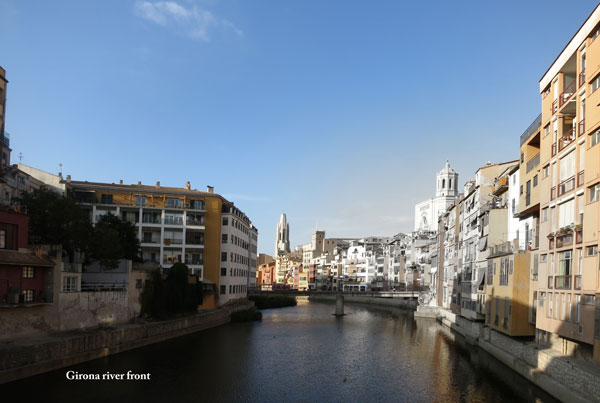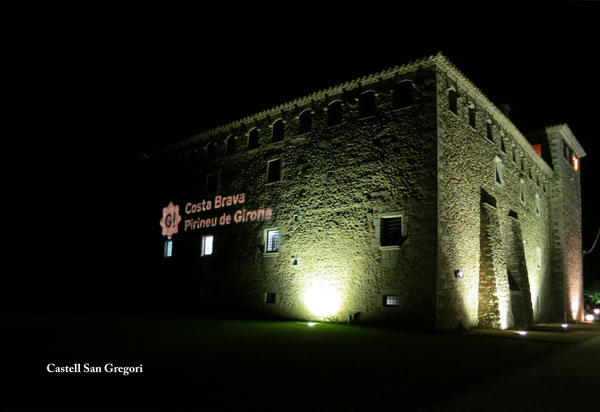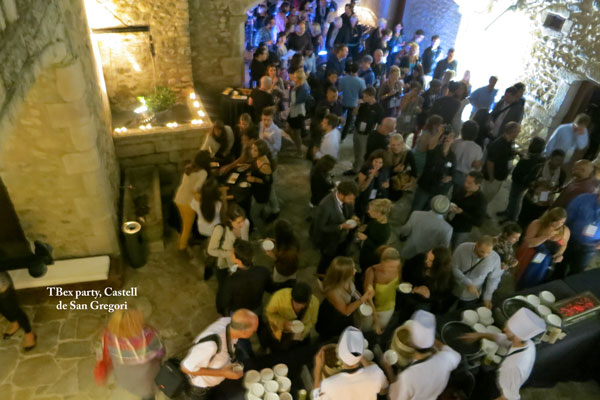by Elyn Aviva
Unwittingly, my husband, Gary, and I walked into an alternative virtual reality. We were surrounded by aliens who looked human. Aliens who spoke a language that sounded like English, but their vocabulary was subtly different. Words like “ROI,” “SEO,” and “hashtags” peppered their speech.
And they communicated with odd body language. Although they seemed to be talking to each other, they rarely made eye contact. Instead, they stared intently at small, vibrating, hand-held devices with brightly lit screens. And they kept tapping these strange pieces of equipment, sometimes with one finger, sometimes with several, or sometimes with their opposable thumbs. Occasionally, their eyes flicked up from the screen to glance around. But only for a moment.
Into what strange world had we wandered? An international travel bloggers conference in Girona, Catalonia, Spain. It sounded appealing in the invitational email: inexpensive, educational, entertaining—and it included a visit to a castle. AND it was taking place in my adopted home town of Girona, so why not?
In this alternative universe, everything was baffling, including the meaning of words I thought I knew. “Relevant” meant “meeting your fans where they’re at” and “content” meant maximizing your Google indexability (the number of searchable key words in your website or blog). “Service” writing” meant providing information and the rush to publish meant some bloggers are posting not weekly but daily or even hourly. A popular book author was called a “long-form print guy.” “Engagement” referred to how actively engaged your Facebook (or blogsite) fan base is, not to a diamond ring.
In this odd universe, Trish, a very knowledgeable member of the community, befriended us and gave us a crash course in bloggerland and language. We learned about product placement, corporate sponsorship, and affiliate links as ways bloggers “monetize” (make money from) their online presence. Trish patiently explained that SEO means “search engine optimization” and ROI is “return on investment.”
It soon became clear that we were the aliens, the ones who had come from a different reality.
Eager to see Girona through different eyes, we went on the guided city tour, something we had never done in the 2.5 years we have lived in Girona. Like many New Yorkers who don’t visit the Statue of Liberty—because it’s too obvious? Too easy?—we had never taken an official guided tour of our home town.
We learned that until the 1970s, the harmonious riverside cityscape featured in Girona picture postcards had been dingy and dismal, with open latrines dumping waste into the Onyar River. And that the stunning red steel bridge constructed by the same Eiffel as the Eiffel Tower—but 10 years earlier—was the sole survivor of four that had been built over the rivers in Girona. The cathedral, with its widest-in-the-world Gothic nave, was built over a Roman temple, and a later building on the site once served as a mosque. The town’s patron, Saint Narcis, is also patron of flies. (It’s a long story. Don’t ask.) We also learned that the missing bronze street plaques in the Call (the medieval Jewish quarter) had been stolen, along with the bronze statue of a witch in the Frenchwoman’s Garden. By looking through new eyes, we were able to experience our hometown in a fresh way, deconstructing some of our long-held assumptions.
Later that evening we were bused (along with 200+ attendees) to the opening night party in a nearby castle—Castell de Sant Gregori (http://www.castelldesantgregori.com), originally built in the twelfth century and amended over the centuries. The evening was catered by El Celler de Can Roca, a three-Michelin-star Girona restaurant ranked second best in the world by http://www.theworlds50best.com. Thanks to TBex and its sponsors, we were able to gorge ourselves on delicious appetizers free-of-charge in a romantic setting. We loved the unadorned stone walls of the castle (actually, a large country mansion) that glowed golden against the darkened sky, lit from outside and from within.
Once inside the castle, we encountered numerous smiling, black-clad servers threading their way through the crowd. They carried large trays laden with enticing appetizers: crisp bacon wrapped around almost-melting banana slices; luscious spheres of liqueur magically encased in a tiny skin of gelatin, topped with a spot of gold leaf; rounds of goat cheese covered with mango puree, served in a spoon; thin, crisp rounds of what tasted like cocoa mixed with dark sesame seeds; small cups of creamy risotto spiked with wild mushrooms—to name a few. And there was free-flowing cava, the Catalan equivalent of champagne.
A cheese expert carefully spooned out the softer cheeses and placed them on toasted bread for the guests. Because I have a gluten allergy, he placed my selections on gluten-free toast. While he molded the softer cheeses between two spoons, he regaled me with information. He thought that sliced apples would enhance Torta del Casar, a creamy, pungent sheep cheese from Extremadura. The milk is coagulated with cardoon (a wild thistle), giving it a slightly bitter taste that complements its rich salty flavor. He recommended grapes coated with sugar to add to the taste of Cabrales, a blue, mixed-milk cheese from Asturias. Thinking I knew something, I suggested membrillo (quince jam) to go with Manchego, a cured sheep cheese from la Mancha. After all, the two are frequently served together in restaurants. The cheese maven disagreed. Who was I to argue with Mr. Cheese?
We also sampled aged “pata negra bellota” jamón ibérico, dry-cured Spanish ham made from the meat of an indigenous, black-hoofed Iberian pig (hence, pata negra) that had been fattened on acorns (hence, bellota). The difference between this jamón ibérico and normal jamón serrano was as great as the difference between American-style lunchmeat and cured Virginia ham.
Then the desserts. A small glass bowl of mixed berries with yogurt ice-cream and a playful chocolate-coated cream-filled “cigar”; skewers of fresh tropical fruit; and various multilayered cakes. And an open bar. Maybe the latter is why, as the evening wore on, the spacious patio filled with bloggers dancing enthusiastically to the excellent band. We were among the first to leave, however. Overstuffed and overstimulated, we collapsed into the first bus pointing back toward Girona.
During the next few days, we attended talks (“breakout sessions”) and keynotes performed by a variety of speakers. Like Will, whose popular blogs specialize in sex and travel, profanity and travel, sheep and—don’t ask. His colleague Pam told us that good creative travel writing “is all about getting naked” (figuratively). She said anybody can Google facts: what a good travel piece offers, however, is something that enriches the reader’s life experience. Both Pam and Will emphasized the importance of strong storytelling, brutal editing, and that you don’t have to publish everything you write. These seemed like novel ideas to many in the audience.
In a different breakout session, Shannon told us that in order to maximize our SEO (search engine optimization), our blogs and websites have to be highly indexable—and the more so the better. She informed us that nobody does a Google search for arty writing: people are looking for information, not atmosphere. Apparently these aliens disagree about what constitutes good travel writing: emotionally charged narrative or easily accessed facts.
Despite our initial disorientation and confusion, we ended up with a number of important “take-aways” (key points to remember). One of the most significant was that sometimes it is useful to be among aliens to experience the world from a new perspective.
Elyn Aviva is a transformational traveler, writer, and fiber artist. Currently living in Girona (Catalonia), Spain, she is fascinated by pilgrimage and sacred sites. Her PhD in anthropology was on the modern Camino de Santiago in Spain. Aviva is author of a number of articles, books, and novels on pilgrimage and sacred sites. She is co-author with her husband, Gary White, of the series “Powerful Places Guidebooks.” The most recent one is Powerful Places in Wales. To learn more about Elyn or her publications, go to www.pilgrimsprocess.com, www.powerfulplaces.com, and www.powerfulplaces.info. To learn about Elyn’s fiber art, go to www.fiberalchemy.com.




